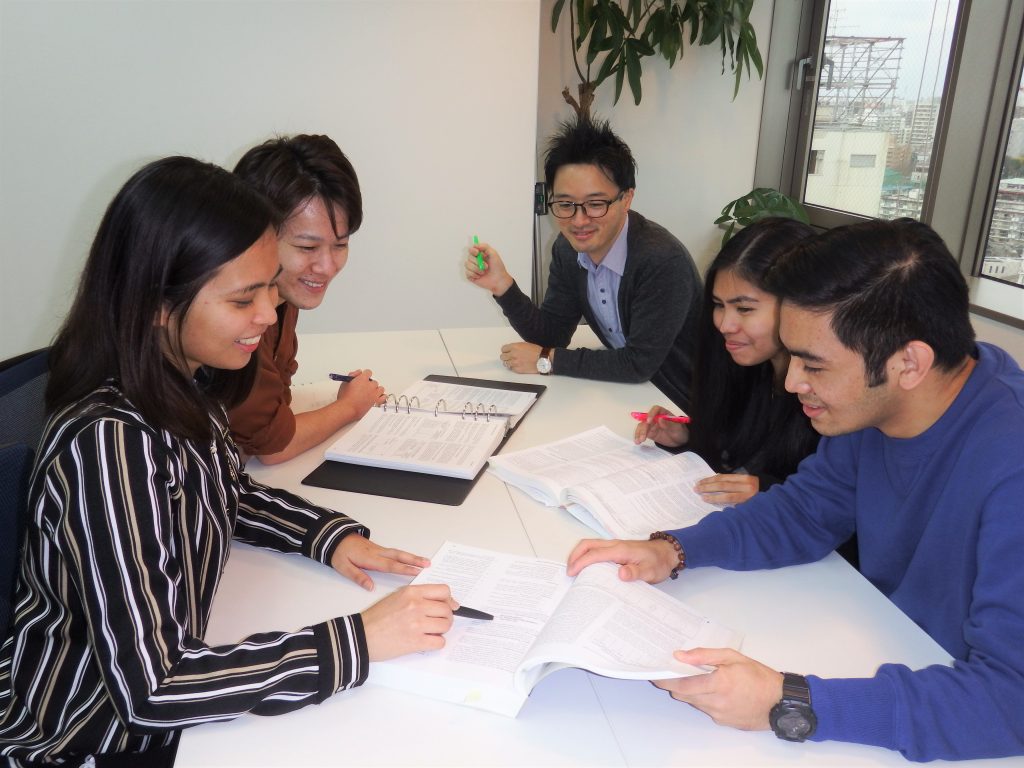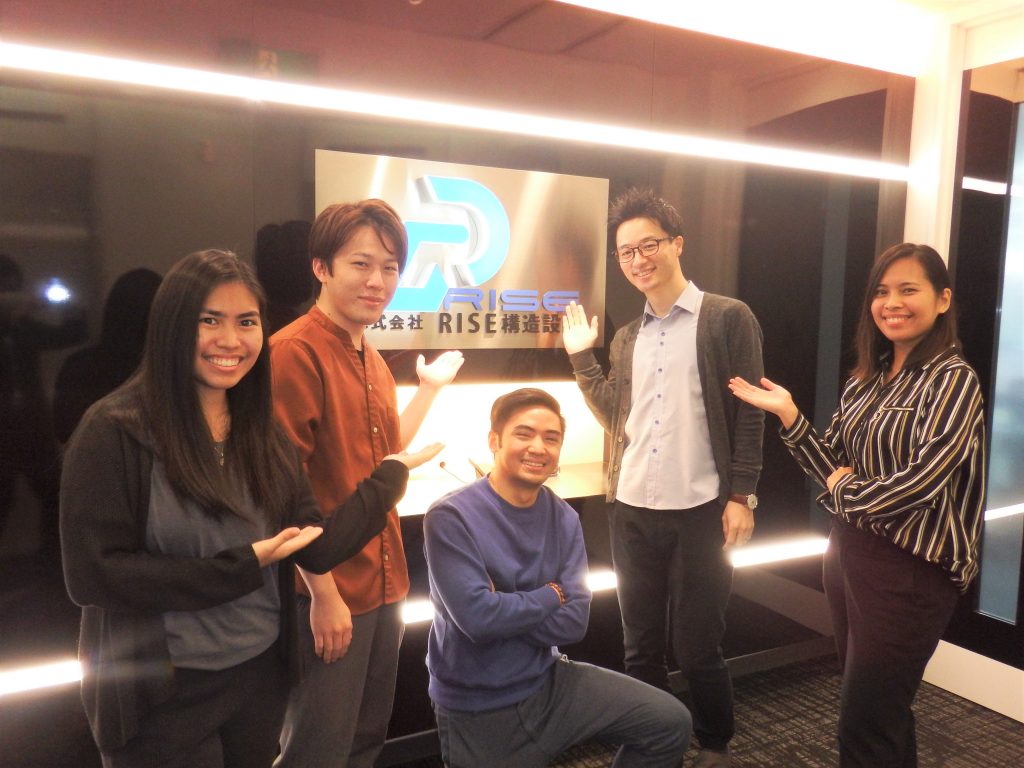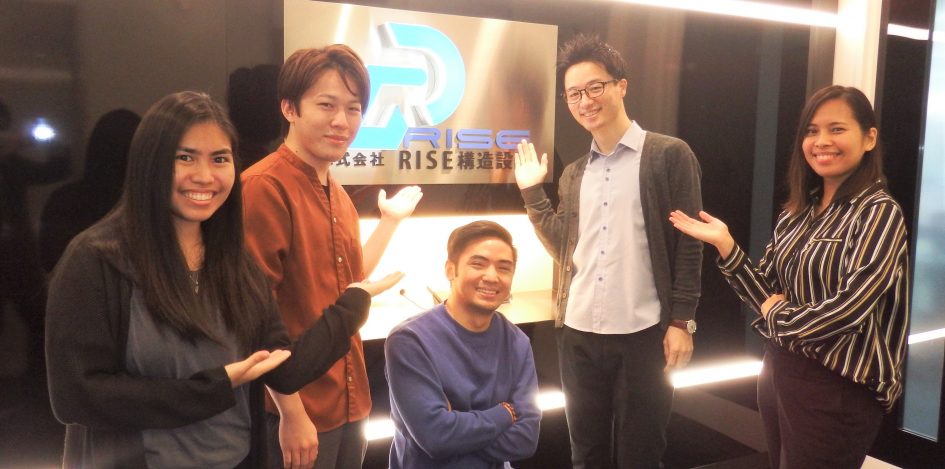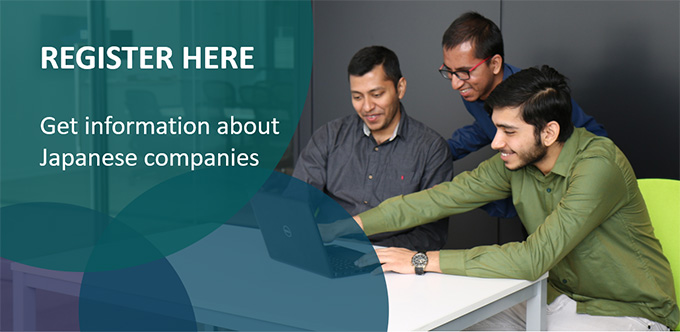Who we are
HQ : Tokyo
Established : 2005
Employees : 32
https://rise-str.com/en/
RISE is a group of professional engineers specializing in structural design and analysis.
We provide a wide range of structural design and analysis services, from common buildings to unusual constructions as well as overseas plant sites.
We aim to be acknowledged in Japan, as well as Overseas, as a highly reliable company which can efficiently and effectively answer to the conditions of the wide range of clients in the construction industry.
We embrace the SDGs by contributing to Goals No. 5, 7, 8, 10, and 11, and are planning on gradually work on further goals in the near future. Through the SDGs, we hope to find like-minded organizations to cooperate with as we build a sustainable society.
Our vision
Corporate philosophy
We, as Structural Designers, will continue to support social security and safety through the pursuit of higher level of expertise and technical capabilities.
We are committed to the following actions to deliver on our three missions
1. Client First
Comply with delivery dates
Ensure safety, rationality, durability, economic efficiency
Offer high-level design skills that exceed clients’ expectations
Convey simply, clearly and briefly difficult design concepts
2. Quality Enhancement
Pursue further knowledge through the latest technologies and skills
Achieve the highest degree of expertise in the Plant Industry
Commit to self-improvement
Support the growth of each and every employee within the company
3. Compliance with Laws and Regulations
Be a team of professionals that ensure high level of safety at all time
Maintain a high level of expertise by hiring many first-class structural design Architects

Our services/products
Our business activities include four main fields
1. Plant Design
Frame and its Foundation Design, Chimney and Tower Construction Design, Tank and Machinery Foundation Design, High Pressure Gas Facilities and/or Equipment Seismic Design, Box Culvert and Underground Pit Design, Plant/Structure based on Overseas Code and Specification Design, Mat-slab Foundation Design, Vibration Analysis and FEM Analysis
2. Building Design
Building Design (Steel, RC, Steel-framed RC, Wall RC, Composite Structure), Limit Strength Calculation, Thin Sheet Light-weight Steel Building Design (Steel House)
3. Piping Design
Pipe Thermal Stress Analysis (ASME), Piping Seismic Analysis (High Pressure Gas Facilities Seismic Design Guidelines Level 1, Level 2, Fire Services Act, etc.)
4. Seismic Diagnosis
Existing Building Seismic Diagnosis (Steel, RC, Steel-framed RC, Wall RC, Composite Structure, etc.), Existing Structure Seismic Diagnosis (Tank type, Frame, Piperack, etc.)
Skills
Our engineering team
What projects/services is your engineering team working on?
Plant design
Plant refers to various types of sites, such as Petroleum, Process or Chemical Plants which are essential for society as they are a key element in the maintenance of lifelines, as well as production of necessities for daily life.
As pipes and equipment usually contain hazardous and deleterious substances, which might cause leakage into the surrounding environment in case a disaster or an accident occurs, plants require a higher safety system than typical buildings. Therefore in Plant Design, each structure must be strongly built against thermal stresses, earthquake forces, and other external forces, in order to maintain urban functions and to serve as an infrastructure that will support the socioeconomic activities of our society.
Plant Design results in massive projects which require a lot of manpower. Diverse divisions take part to the project along the way, such as project department, piping design department, electrical instrumentation department, machine design division, civil engineering department that designs structures to support plant equipment, and other departments that also play a variety of roles. Since there a lot of departments working in the design phase, it is important that all departments maintain communication with each other while the project is on-going.
Also, since the design conditions are greatly influenced by the climate of the construction site, we need to understand to some extent the customs and environment of the country. Every country has its own Basic Design Code but because there are criteria peculiar to each country, it is important to first understand and grasp those criteria.
Sometimes these projects are very challenging, but we always strive to find a solution and draft the best proposals for our customers.
Architectural structural design (building design)
In Architectural Structural Design, we read the design specifications and determine the design conditions, function of the building, etc. During that process, we also assume the weight (live load) supported by the building and decide what framework is needed according to the law or standard. While deciding on the framework, we also consider factors such as earthquakes, wind, snow, etc. that might effect the load supported by the building.
In addition to achieving a level of structural design approved by relevant authorities, we aim to design buildings that are affordable and stronger, pursuing higher level of building design while responding to our clients’ demands.
Since Japan is an earthquake-prone country, buildings, plants and piping are designed to withstand earthquakes. Especially when it comes to buildings, the structure must be tenacious enough to allow the people inside to evacuate safely, whatever unexpected situation occurs.
For buildings not to easily collapse, they must be able to bend, extend and stretch. When you pull a metal wire, it will stretch to a certain point but you will not be able to cut it instantly. By applying a similar concept to architecture, we design buildings that are tenacious and therefore will not collapse right away.
It is a difficult process but it is rewarding once we’ve determined the flow of the forces and successfully optimized the design. We also feel a great sense of accomplishment while checking the finished building.
Piping design
If we compare plant equipments such as pumps, heat exchanger, turbines etc. to human organs, pipes would be the human blood vessels (artery and vein). Equipments are important but would be meaningless by themselves. Only after being connected by pipes are they able to play their role.
Since various considerations are required to circulate different kinds of fluids, it is important to have a comprehensive viewpoint in Piping Design.
The contents (fluids) are highly flammable and toxic. For example, a piping system connected to a tank in which a large amount of hazardous materials are stored must be designed while considering various possibilities so as not to allow any leakage or damage.
In addition, it is important to arrange the schedule while keeping in contact with everyone from the early stages of the design. When remodeling high pressure gas piping, meeting the deadline is of utmost importance since construction can not be carried unless there is examination from the municipality that controls the plant.
Drafting a safe piping design contributes highly to society and people, leads to profits, and is a very important job because people’s life is in your hands.
Seismic Diagnosis
When a building is damaged due to a major earthquake, the country researches on the cause of failure and tries to find out the weak points as well as the seismic performance. Using these new knowledge, the Building Standard Act may be revised so as to prevent future damage due to the same kind of disaster. The latest revision to this standard in Japan was made in 1981.
In seismic diagnosis, we check buildings designed before the 1981 revision, assess whether the shape is easily damaged, or whether degradation due to aging is becoming a problem. We investigate whether there are parts that could become weak points at the time of a large earthquake and carefully examine the necessity of re-calculating the seismic performance of the building and providing additional reinforcements.
Maintenance of plants is done on a daily basis. Depending on the result, the range of reparation work may increase, design drawings may have to be revised, and maintenance procedure and/or methods may be affected.
Thus, seismic diagnosis influences the entire process and requires time and money. To minimize these costs, we need to be careful and scheduling and regular communication between teams.

What technologies are you using?
We use the following design softwares
- 3D Structural Analysis: STAAD Pro, MIDAS Gen, MIDAS iGen, eGen
- Consistency Calculation: SEIN La CREA, Super Build SS3, Super Build SS7
- Pipe Stress Analysis: AutoPIPE, CAESAR Ⅱ
- Seismic Diagnosis: DOC-RC/SRC, RC Diagnosis 2001, S Seismic Diagnosis
- Foundation Design: Super Build/BF1, STAAD Foundation Advanced
- Elastic Stress Analysis: FAP-3
- Cross Section Calculation: MED-3
- Steel Secondary Member Calculation: MC-1, S Chart
- RC Secondary Member Calculation: RC Secondary Member, RC Chart
- Estimation: Super Build
- CAD: AutoCAD, Navisworks, Tekla Structures, Revit
- FEM Analysis: MIDAS NFX, MIDAS GTS NX
What type of engineers work at your company? What is their job content?
We have structural design engineers and piping design engineers, performing diverse duties
- General building structural design
- Plant Structure Design
- Building/Plant Structures Seismic Diagnosis
- Various structural designs according to overseas design standards
- Piping design
Do you plan on using any new technologies in the future?
In the future, we plan on developing simple reinforcement methods that can be easily adopted by anyone, anywhere, so as to contribute to building a city that is resilient to disasters such as earthquakes.
Career step up
1st year
Learning to draw and calculate
2nd year
Becoming an engineering designer and interacting directly with customers
3rd year
Expanding the scope of one’s work by taking on more difficult tasks and training junior staff
Although non-Japanese employees follow the same path as Japanese ones, after joining the company they first use English to communicate at work.
At RISE, we treat people fairly regardless of their nationality, race, or gender, but on the other hand, we require the same level of work performance as Japanese employees.
Therefore, we are expecting our foreign national members to learn Japanese as soon as possible in order to deal with phone calls and emails, to communicate with customers, and perform research work on site.
Our corporate culture
We implemented a system to evaluate each person’s growth and skills fairly, by dividing tasks into different levels of difficulty and rating them on a scale of three to five.
Through that evaluation system, one can check one’s current skill level as well as the skills one will need in the future. As improving one’s skills leads to salary raise, it is a clear evaluation system that visualises employees’ growth in a clear way that can be directly reflected in pay raises and bonuses.
Our training system includes
- Business Manner Training
- Participation in various structural design workshops (optional)
- Implementation and presentation delivering at in-house workshops
Overall, most of the training is on-the-job training (OJT)
We consider practice to be of the utmost importance. Although there are various projects, we sometimes form cross-departmental teams to carry out design work according to the skills of each individual.
Benefits
In addition to partnerships with various facilities and stores, including the Tokyo Disney Resort, we offer a wide range of mutual aid and insurance programs.
A bowling tournament is held every year within the company, followed by a party to celebrate the event.
Company trips are also held every year. In the past, our employees traveled to Hong Kong, Vietnam and Cebu.
Every year, a budget of 100,000 JPY (about 950$) per person is provided for recreational activities such as company trips.
How it is spent during the year is decided by the secretary.




